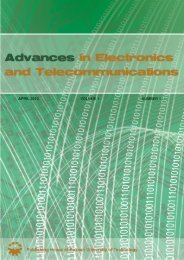november 2010 volume 1 number 2 - Advances in Electronics and ...
november 2010 volume 1 number 2 - Advances in Electronics and ...
november 2010 volume 1 number 2 - Advances in Electronics and ...
You also want an ePaper? Increase the reach of your titles
YUMPU automatically turns print PDFs into web optimized ePapers that Google loves.
40 ADVANCES IN ELECTRONICS AND TELECOMMUNICATIONS, VOL. 1, NO. 2, NOVEMBER <strong>2010</strong><br />
Fig. 12. The maximum VOMQ size, bursty traffic.<br />
Fig. 13. Average cell delay for selected request-grant-accept algorithms (four<br />
iterations) <strong>and</strong> the proposed schemes, uniform traffic.<br />
Fig. 14. Average cell delay for selected request-grant-accept algorithms (four<br />
iterations) <strong>and</strong> the proposed schemes, trans-diagonal traffic.<br />
The <strong>in</strong>vestigated request-grant-accept packet dispatch<strong>in</strong>g<br />
schemes are based on the effect of desynchronization of<br />
arbitration po<strong>in</strong>ters <strong>in</strong> the Clos-network switch. We have<br />
made an attempt to improve the desynchronization method<br />
for the CRRD-OG scheme to ensure 100% throughput for the<br />
nonuniform traffic distribution patterns. Additional po<strong>in</strong>ters<br />
<strong>and</strong> arbiters for open grants were added to the MSM Clos<br />
switch<strong>in</strong>g fabric but the scheme was not able to provide 100%<br />
throughput for the nonuniform traffic distribution patterns.<br />
To the best of our knowledge, it is not possible to achieve<br />
very good desynchronization of po<strong>in</strong>ters us<strong>in</strong>g the methods<br />
implemented <strong>in</strong> the iterative packet dispatch<strong>in</strong>g schemes. In<br />
our op<strong>in</strong>ion, the decisions of distributed arbiters have to be<br />
Fig. 15. Average cell delay for selected request-grant-accept algorithms (four<br />
iterations) <strong>and</strong> the proposed schemes, bi-diagonal traffic.<br />
supportedbythecentralarbiterbutthe implementationofsuch<br />
solutions <strong>in</strong> the real equipment will be very complex. Therefore<br />
the algorithms, which are able to unload the overloaded<br />
<strong>in</strong>put buffers like SD-FC <strong>and</strong> IOM should be implemented.<br />
V. CONCLUSION<br />
We have proposed the SD-FC, SD-OC, <strong>and</strong> IOM packet<br />
dispatch<strong>in</strong>g schemes for the MSM Clos switch<strong>in</strong>g fabric. The<br />
algorithmsemploy the central arbiter to match IMs with OMs.<br />
In SD-FC <strong>and</strong> IOM schemes the arbiter performs relatively<br />
simple functions. Simulation experiments have shown that the<br />
proposed schemes are very promis<strong>in</strong>g <strong>and</strong> give very good<br />
resultsfor boththe uniform<strong>and</strong> nonuniformtraffic distribution<br />
patterns. The algorithms can manage all <strong>in</strong>vestigated traffic<br />
patterns very effectively, provid<strong>in</strong>g 100% throughput. This is<br />
a highlydesirablepropertyofthe packetdispatch<strong>in</strong>galgorithm<br />
for the switch<strong>in</strong>g fabric of the next generation packet node.<br />
A hardware implementation of the central arbiters required by<br />
the proposed schemes will be subject to further research.<br />
REFERENCES<br />
[1] J. Chao <strong>and</strong> B. Liu, High Performance Switches <strong>and</strong> Routers. New<br />
Jersey: Wiley, Hoboken, 2007.<br />
[2] K. Yoshigoe <strong>and</strong> K. J. Christensen, “An evolution to crossbar switches<br />
with virtual ouptut queu<strong>in</strong>g <strong>and</strong> buffered cross po<strong>in</strong>ts,” IEEE Network,<br />
vol. 17, no. 5, pp. 48–56, 2003.<br />
[3] E. Oki, R. Rojas-Cessa, <strong>and</strong> H. J. Chao, “A pipel<strong>in</strong>e-based approach for<br />
maximal-sized match<strong>in</strong>g schedul<strong>in</strong>g <strong>in</strong> <strong>in</strong>put-buffered switches,” IEEE<br />
Commun. Lett., vol. 5, no. 6, pp. 263–265, 2001.<br />
[4] E. Oki, Z. J<strong>in</strong>g, R. Rojas-Cessa, <strong>and</strong> H. J. Chao, “Concurrent<br />
round-rob<strong>in</strong>-based dispatch<strong>in</strong>g schemes for Clos-network switches,”<br />
IEEE/ACM Trans. on Network<strong>in</strong>g, vol. 10, no. 6, pp. 830–844, 2002.<br />
[5] R. Rojas-Cessa <strong>and</strong> H.J.Chao, “Maximum weight match<strong>in</strong>g dispatch<strong>in</strong>g<br />
scheme <strong>in</strong> buffered Clos-network packet switches,” <strong>in</strong> Proc. of IEEE<br />
International Conference on Communications, ICC 2004, Paris, France,<br />
2004, pp. 830–844.<br />
[6] K. Pun <strong>and</strong> M. Hamdi, “Dispatch<strong>in</strong>g schemes for Clos-network<br />
switches,” Computer Networks, no. 44, pp. 667–679, 2004.<br />
[7] Y. Jiang <strong>and</strong> M. Hamdi, “A fully desynchronized round-rob<strong>in</strong> match<strong>in</strong>g<br />
scheduler for a VOQ packet switch architecture,” <strong>in</strong> Proc. of IEEE High<br />
Performance Switch<strong>in</strong>g <strong>and</strong> Rout<strong>in</strong>g, HPSR 2001, May 2001, pp. 407–<br />
411.<br />
[8] J. Y. Hui <strong>and</strong> E. Arthurs, “A broadb<strong>and</strong> packet switch for <strong>in</strong>tegrated<br />
transport,” IEEE J. Sel. Areas Commun., vol. 5, no. 8, pp. 1264–1273,<br />
Oct. 1987.<br />
[9] C. B. L<strong>in</strong> <strong>and</strong> R. Rojas-Cessa, “Frame occupancy-based dispatch<strong>in</strong>g<br />
schemes for buffered three-stage Clos-network switches,” <strong>in</strong> Proc. of<br />
13th IEEE International Conference on Networks 2005, 2005.







